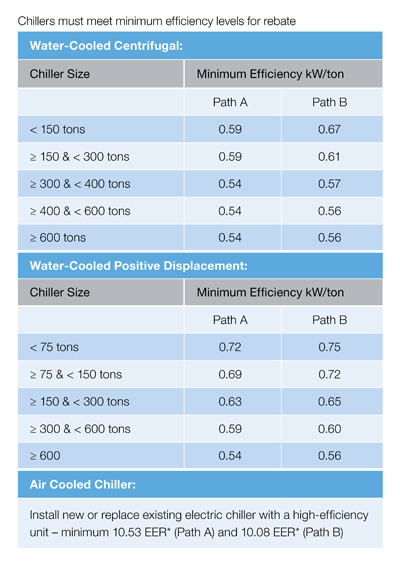Did you know that heating and cooling alone can use 50% of the energy in commercial buildings?
Our Business HVAC Program can help. We offer energy-saving solutions that can make a real difference to your organization.
Plus, you may qualify for rebates to help with the upfront investment costs.
Explore our systems
Chiller
Get an average rebate of $3,000* per project while balancing energy savings and a comfortable environment. Our program helps your business manage energy expenses effectively, ensuring optimal comfort for employees, customers and equipment
There are two types of chillers: air-cooled and water-cooled which simply describes how the chillers’ condenser is removing heat from the building.
Chillers are refrigeration systems that produce and circulate chilled water to air-handler units. Inside the air-handler units, fans push air across the evaporator coils to cool and dehumidify air.
They are typically found in larger commercial/industrial facilities with combined loads of 100 tons or more.
Related resources
Direct-Expansion Air Conditioning
Receive an average rebate of $5000* per project when upgrading to more efficient cooling systems. Air conditioning costs typically account for 50% of a business's energy bill, but newer systems can help offset these expenses.
See if you qualify by contacting a program specialist.
DX A/C is just a technical term for a standard air conditioner or commercial HVAC system including split systems, mini splits, packaged type units and rooftop units.
The inside air-handler unit uses a fan to push air across the evaporator coil, which absorbs heat to cool and dehumidify air. It works with the outdoor condenser unit to release the heat from the freon to the outside so it can return and absorb more heat.
- Air, water and evaporative-cooled A/Cs and heat pumps
- Single vertical package A/Cs and heat pumps
- Variable refrigerant flow A/C sand heat pumps, both air-cooled and water-cooled
- Computer Room cooling systems- air, water, and glycol cooled
- Package terminal A/Cs or heat pump systems
- Units that exceed the Florida Building Code
Visit the U.S. Department of Energy's website for a calculator that computes the lifetime energy cost savings for rooftop units.
Related resources
Variable Frequency Drive
Receive an average rebate of $5,000 per 25-horsepower unit when installing variable frequency drives. VFDs typically reduce energy consumption by 20-50% by adjusting pump speeds to match demand.
Related resources
Get pre-approved
If you’re interested in installing new HVAC systems or upgrading existing, please complete the form and a program specialist will reach out to you.
Ready to sign up?
Simply complete our form and a Business Energy Expert will be in touch within two (2) business days to assist with determining your eligibility for enrollment. Please note: one or more A/C units are required for enrollment.
When you upgrade your indoor lighting and HVAC systems to improve energy efficiency, your business may qualify for federal tax credits administered by the IRS.
*Note: The rebate amounts depend on the size of the installation per project.
